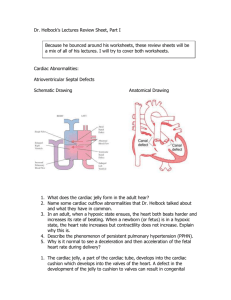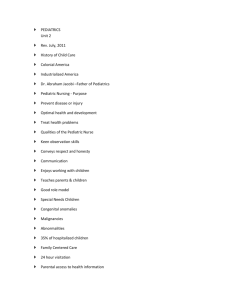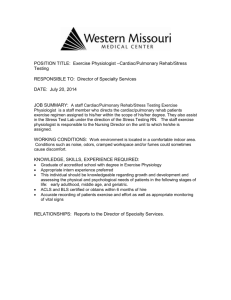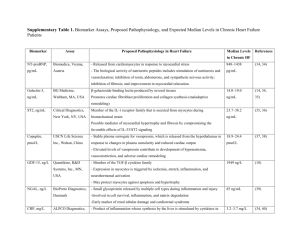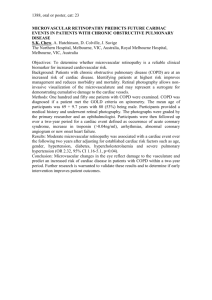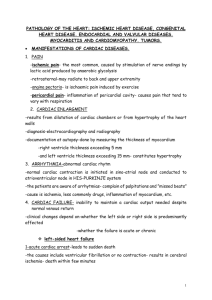III- FILL
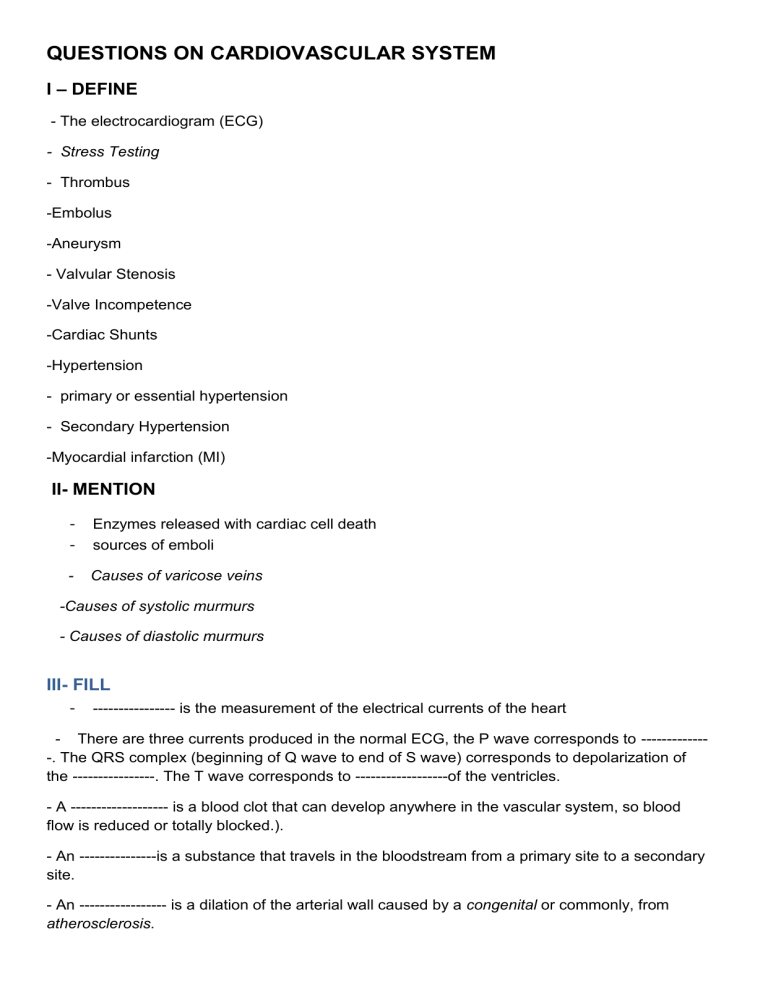
QUESTIONS ON CARDIOVASCULAR SYSTEM
I – DEFINE
- The electrocardiogram (ECG)
- Stress Testing
- Thrombus
-Embolus
-Aneurysm
- Valvular Stenosis
-Valve Incompetence
-Cardiac Shunts
-Hypertension
- primary or essential hypertension
- Secondary Hypertension
Myocardial infarction (MI)
II- MENTION
Enzymes released with cardiac cell death
sources of emboli
- Causes of varicose veins
-Causes of systolic murmurs
- Causes of diastolic murmurs
III- FILL
---------------- is the measurement of the electrical currents of the heart
- There are three currents produced in the normal ECG, the P wave corresponds to -------------
-. The QRS complex (beginning of Q wave to end of S wave) corresponds to depolarization of the ----------------. The T wave corresponds to ------------------of the ventricles.
- A ------------------- is a blood clot that can develop anywhere in the vascular system, so blood flow is reduced or totally blocked.).
- An ---------------is a substance that travels in the bloodstream from a primary site to a secondary site.
- An ----------------- is a dilation of the arterial wall caused by a congenital or commonly, from atherosclerosis.
- --------------- of any valve is narrowing usually occurs as a result of a congenital defect or an inflammatory process (e.g., after rheumatic fever).
A -------------------shunt lead to hypertrophy of pulmonary vasculature and right heart failure may develop
-------------------- is characterized by accumulation of fatty deposits, platelets, neutrophils, monocytes and macrophages throughout the tunica intima (endothelial cell layer) and eventually into the tunica media (smooth muscle layer).
- Arteries most often affected by atherosclerosis include the------
------------------------is an aching, cramping feeling in the lower extremities due to muscle ischemia.
---------------- is temporary spasm of the small arteries and arterioles, usually in the fingers or, less frequently, the toes.
-----------------------are tortuous (twisted) distended veins occurring where blood has pooled, often in the legs.
---------------------- is severe pain due to an inadequate oxygen supply to the myocardial cells.
------------------- is a combination of classic and variant angina, and is seen in an individual with worsening coronary artery disease.
---------------- is the death of myocardial cells that occurs following prolonged oxygen deprivation.
-
- --------------------is a serious inflammatory disease that may occur in an individual 1 to 4 weeks following an untreated throat infection by the group A betahemolytic Streptococcus bacteria.
------------------is a narrowing in the opening of the valve between the left atrium and the left ventricle.
--------------------is a narrowing in the opening of the valve between the left ventricle and the aorta.
--------------- is a narrowing of the opening between the right ventricle and the pulmonary valve.
-
---------------------is an abnormal opening between the left and right atria.
---------------------Is an abnormal opening between the left and right ventricles.
-If the connection between the pulmonary artery and the aorta, remains open after birth,the condition is called-----------------.
-----------------------is a congenital defect that results in the narrowing of the aorta as it leaves the left ventricle. The narrowing can be proximal or distal to the ductus arteriosus.
---------------- is the collapse of systemic arterial blood pressure.
- -----------------------shock can occur following collapse of the cardiac output, which often results from a myocardial infarct, fibrillation, or congestive heart failure.
- ------------------ shock can occur if there is a loss of circulating blood volume, causing a severe drop in cardiac output and blood pressure.
- ---------------------shock can occur following a widespread allergic response -
- -----------------shock can occur following a massive systemic infection -
- ---------------------shock occurs following sudden loss of vascular tone from an injury to the
cardiovascular center of the brain, a spinal cord injury, or deep general anesthesia. This type of occurrence may explain sudden fainting during a severe emotional disturbance.
-
- Hemorrhage and dehydration can cause hypovolemic shock.
-
-
IV- TRUE OR FALSE
Echocardiography is highly sensitive and non-invasive and provides a visual image of the beating heart.
- In cardiac catheterization a flexible tube (catheter) is inserted through a peripheral vein
(femoral or brachial) into the right side of the heart, or through a peripheral artery (femoral or brachial) into the left side of the heart.
- Through the catheter, the chambers of the heart can be visualized and chamber pressures and oxygen content measured.
- A radiolabeled dye may be injected through the catheter, and the ability of the dye to move through the heart chambers and vessels may be monitored using x-ray techniques.
- Valve movement can be observed.
- Because cardiac catheterization is invasive, complications are possible , including tearing of the vessel wall.
- After cardiac catheterization , patients must lie still for 4 to 6 hours until leg vessels seal.
- Most emboli are : blood clots (thromboemboli) usually from deep leg veins.
- After birth, any shunting is abnormal.
A right to left shunt is called a cyanotic shunt
- Left-to-Right Shunt is acyanotic
- A cardiac shunt is a connection between the pulmonary and the systemic circulations.
- Lactic acid decreases myocardial pH and causes the pain associated with angina pectoris
-The pain of stable angina typically goes away when the individual stops the activity
- Prinzmetal's(variant ) angina occurs during rest or sleep.
- In stable and unstable angina, pain is typically relieved by rest.
- In Prinzmetal's angina,pain is unrelieved by rest but usually disappears in about 5 minutes.
-Some individuals do not show any obvious signs of an MI (a silent heart attack)
- VSD is the most common cardiac congenital defect.
- Tetralogy of Fallot is a cyanotic defect.
V- MCQ
*Clinical Manifestations of atherosclerosis include a - Intermittent claudication, an aching, cramping feeling in the lower extremities due to muscle ischemia b- Cold sensitivity occurs with inadequate blood flow to the extremities.
c- The area becomes pale.
d- Reduced arterial pulses e- all
* Complications of atherosclerosis includes a - Hypertension b- Stroke c- MI d- Development of an aneurysm.
e- all
* Causes of Hypertension a- Increase in heart rate b-increased peripheral resistance c- increase in plasma volume d- increased sympathetic nervous system activity.
e- all
* Complications of hypertentions a- Stroke b - A myocardial infarct (MI) c- Renal failure d - Encephalopathy (brain damage) e-all
* Causes of Myocardial Infarct a- long-standing coronary artery disease (CAD). b- large thrombus that totally obstruct blood flow.
c- hypertrophied chambers with relative oxygen deficiency
d- all
*Complications of MI a-Thromboemboli zation b - Congestive heart failure .
c- Cardiogenic shock (collapse of blood pressure).
d- Myocardial rupture may occur after a large infarct. e - Pericarditis.
*Forward Effects of Left Heart Failure a- Decreased systemic blood pressure b- Fatigue c- Increased heart rate d - Decreased urine output
*Backward Effects of Left Heart Failure a- Increased pulmonary congestion, especially when lying down b- Dyspnea (difficult breathing) c- Right heart failure if the condition worsens d- all
*Forward Effects of Right Heart Failure a- Decreased pulmonary blood flow b- Decreased blood oxygenation c-
Fatigue d - Decreased systemic blood pressure
* Backward Effects of Right Heart Failure a- Increased venous pooling of blood, edema of the ankles and feet b- Jugular venous distension c- Hepatomegaly and splenomegaly d- all
*Tetralogy of Fallot is a congenital heart defect characterized by a- ventricular septal defect .
B- pulmonary artery stenosis , c-right ventricular hypertrophy d- a shifting of the position of the aorta so that it opens into the right ventricle (an overriding aorta).

